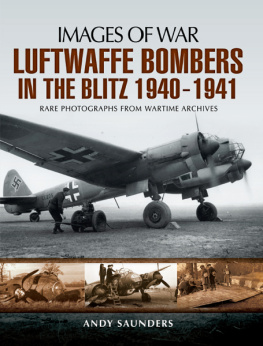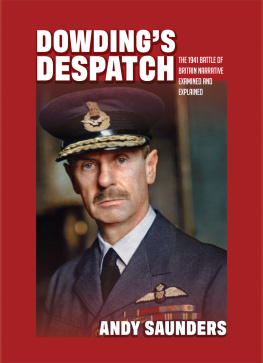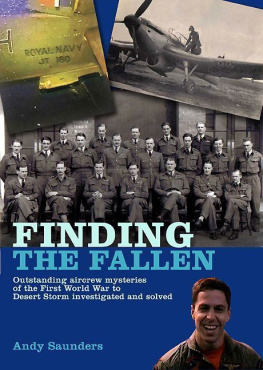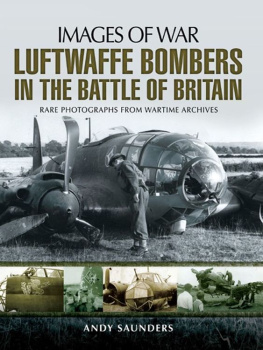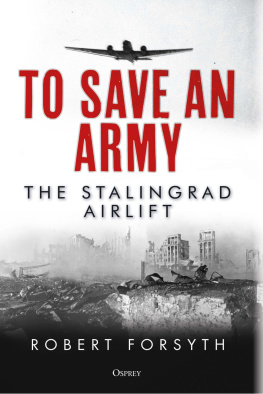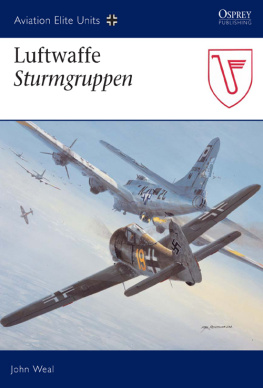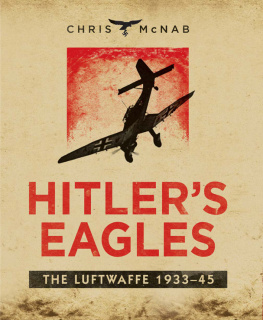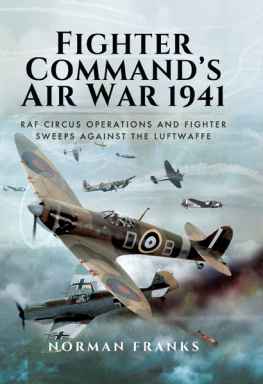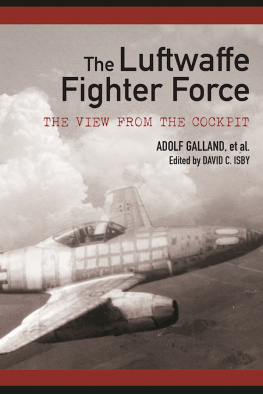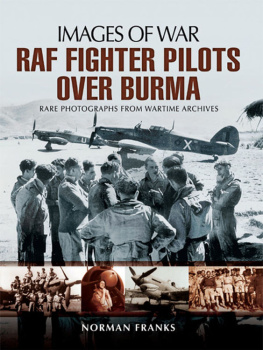Andy Saunders - Luftwaffe Bombers in the Blitz 1940-1941
Here you can read online Andy Saunders - Luftwaffe Bombers in the Blitz 1940-1941 full text of the book (entire story) in english for free. Download pdf and epub, get meaning, cover and reviews about this ebook. year: 2015, publisher: Pen and Sword, genre: Religion. Description of the work, (preface) as well as reviews are available. Best literature library LitArk.com created for fans of good reading and offers a wide selection of genres:
Romance novel
Science fiction
Adventure
Detective
Science
History
Home and family
Prose
Art
Politics
Computer
Non-fiction
Religion
Business
Children
Humor
Choose a favorite category and find really read worthwhile books. Enjoy immersion in the world of imagination, feel the emotions of the characters or learn something new for yourself, make an fascinating discovery.
- Book:Luftwaffe Bombers in the Blitz 1940-1941
- Author:
- Publisher:Pen and Sword
- Genre:
- Year:2015
- Rating:3 / 5
- Favourites:Add to favourites
- Your mark:
- 60
- 1
- 2
- 3
- 4
- 5
Luftwaffe Bombers in the Blitz 1940-1941: summary, description and annotation
We offer to read an annotation, description, summary or preface (depends on what the author of the book "Luftwaffe Bombers in the Blitz 1940-1941" wrote himself). If you haven't found the necessary information about the book — write in the comments, we will try to find it.
Luftwaffe Bombers in the Blitz 1940-1941 — read online for free the complete book (whole text) full work
Below is the text of the book, divided by pages. System saving the place of the last page read, allows you to conveniently read the book "Luftwaffe Bombers in the Blitz 1940-1941" online for free, without having to search again every time where you left off. Put a bookmark, and you can go to the page where you finished reading at any time.
Font size:
Interval:
Bookmark:
First published in Great Britain in 2015 by
PEN & SWORD MILITARY
an imprint of
Pen & Sword Books Ltd,
47 Church Street,
Barnsley,
South Yorkshire,
S70 2AS
Copyright Andy Saunders, 2015
A CIP record for this book is available from the British Library.
ISBN: 978 1 78303 0 224
EPUB ISBN: 978 1 47385 9 401
PRC ISBN: 978 1 47385 9 395
The right of Andy Saunders to be identified as the Author of this
Work has been asserted by him in accordance with the Copyright,
Designs and Patents Act 1988.
All rights reserved. No part of this book may be reproduced or
transmitted in any form or by any means, electronic or mechanical
including photocopying, recording or by any information storage and
retrieval system, without permission from the Publisher in writing.
Printed and bound by CPI UK
Pen & Sword Books Ltd incorporates the Imprints of
Pen & Sword Aviation, Pen & Sword Maritime,
Pen & Sword Military, Wharncliffe Local History, Pen & Sword Select,
Pen & Sword Military Classics and Leo Cooper.
For a complete list of Pen & Sword titles please contact
Pen & Sword Books Limited
47 Church Street, Barnsley, South Yorkshire, S70 2AS, England
E-mail:
Website: www.pen-and-sword.co.uk
Contents
Acknowledgements
The photographs contained in this volume are largely from my private archive of images that I have collected of Luftwaffe aircraft downed in Britain during the period 1939 to 1945. A great many friends and colleagues have assisted me in the quest for these photographs, or otherwise provided additional information. In no particular order of merit, I would like to thank:
Peter Cornwell, Steve Hall, Chris Goss, Dennis Knight, Winston Ramsey, Phillipa Hodgkiss, Alfred Price and Martin Mace.
In addition, I must mention two other fellow researchers who are no longer with us but whos work added considerably to our sum of knowledge relating to the recovery of aircraft wrecks in wartime Britain. They are my late friend Pat Burgess and a colleague of many years, Peter Foote. Pat had been a prodigious collector of information relating to the county of Sussex, the area in which much of the activity described in this book had taken place. Peter Foote had been equally industrious in recording the minutiae of events during the Battle of Britain and the Blitz across Britain since the late 1940s and his tireless research work has left a legacy of unequalled information. Had he not recorded some of these events before it was too late to find the evidence then our knowledge of that period would be much the poorer. In many cases, he put considerable historical detail and context to photographs that would otherwise have been a rather less informative record of the momentous events they depicted.
Lastly, I feel I should mention the late Kenneth Watkins. Ken was a collector of Luftwaffe aircraft crash photographs and after his death I was fortunate to be able to acquire his large collection. Kens photographs complemented and added to those already in my own archive but I was able to extensively draw upon that resource in compiling this book.
In addition, I must extend my thanks to any other individuals and organisations who may have assisted me in over forty years of research and whom I may have inadvertently overlooked. My thanks to you all.
Introduction
Whilst German air attacks on mainland Britain started in October 1939, and to a greater or lesser extent on its towns and cities, it is generally considered that the Blitz began on 7 September 1940 and continued through to the spring of 1941. Unlike the Battle of Britain (10 July 1940 to 31 October 1940) the Blitz has no official commencement and cessation dates. It is accepted that the assault began on 7 September 1940, but its end date was rather less definite. The Luftwaffe air assault on Britains cities just petered out as German efforts turned eastwards towards Russia in Operation Barbarossa. For the purposes of this book, however, the 31 May 1941 has been taken as the cut-off point for the end of the Blitz, because it corresponds with a significant reduction in Luftwaffe raids. Air attacks of a much more limited nature continued pretty much unabated until almost the end of the war in Europe, but never again in such strength as the raids from September 1940 to April 1941.
The word Blitz is short for Blitzkreig, literally lightning war, the word that had been applied to describe the German assault on Poland in 1939 and on France and the Low Countries in 10 May 1940. But it also became the word used to describe the bombing raids on British cities. Of course, 7 September 1940 was also a date that fell during the height of the Battle of Britain and, in reality, the commencement of the Blitz was just a development of Luftwaffe tactics in the air war against Britain. Initially the Battle of Britain had seen attacks on coastal convoys and ports, and then the focus of attack was switched to RAF airfields before this gave way to all-out raids against cities, towns and industrial centres. Initially, these operations were round-the-clock, with the night bombers being guided to their targets by fires stoked during the daylight attacks, and the raids increasingly took a heavy toll on civilian targets.
As with the Battle of Britain, so the Blitz saw its various distinct phases as the Luftwaffe changed its modus operandi to suit tactical requirements and, indeed, in response to operational lessons that were being learned. For example, it quickly became apparent that the daylight raids, even when they were heavily escorted by fighters, remained vulnerable to the still strong defensive organisation that was RAF Fighter Command. A weakness in the aerial defence of Britain, though, could be exploited during the hours of darkness since RAF night-fighting was yet in its infancy and anti-aircraft guns were so inaccurate that they were not a significant factor. However, as the night Blitz gathered pace so the impetus for development and implementation of more effective defensive measures gained momentum and by November 1940 the first successful interception using airborne interception radar (A.I.) resulted in the destruction of a German bomber over land. This event might be considered perhaps the beginning of the end of the Blitz, for the virtual cloak of invisibility that the darkness of night had afforded the German raiders had been lifted. All the same, until RAF night fighting defences (and, later, radar controlled anti-aircraft guns) had got into their stride, the best chance of survival for Luftwaffe bombers remained the night-attack, and by October 1940 the daylight raids had all but ceased. All but ceased, that is, apart from a new innovation that came that autumn: the fighter bomber.
By October the Luftwaffe were sending formations of Messerschmitt 109s carrying single 250kg bombs in attacks mostly against London and in formations that were, in turn, protected with fighter cover provided by other Me 109s. But the operations during October and November of 1940 very much heralded the development of the Germans fighter-bomber (or Jabo) units which would later cause so much havoc, principally in south coast and southern English towns.
As the Blitz continued on into the late autumn and winter of 1940, so the number of towns and cities being attacked widened throughout the length and breadth of Britain. Notable amongst them was Coventry, attacked with devastating results on the night of 14 November 1940. Inexorably, the night raids continued throughout the winter of 1940/41 and on into the early spring, but given the weight of numbers involved in the aerial assaults the numbers of aircraft actually being brought down was not high. Nevertheless, there were casualties aplenty as the attacks came almost night after night so far as weather conditions would permit.
Next pageFont size:
Interval:
Bookmark:
Similar books «Luftwaffe Bombers in the Blitz 1940-1941»
Look at similar books to Luftwaffe Bombers in the Blitz 1940-1941. We have selected literature similar in name and meaning in the hope of providing readers with more options to find new, interesting, not yet read works.
Discussion, reviews of the book Luftwaffe Bombers in the Blitz 1940-1941 and just readers' own opinions. Leave your comments, write what you think about the work, its meaning or the main characters. Specify what exactly you liked and what you didn't like, and why you think so.

